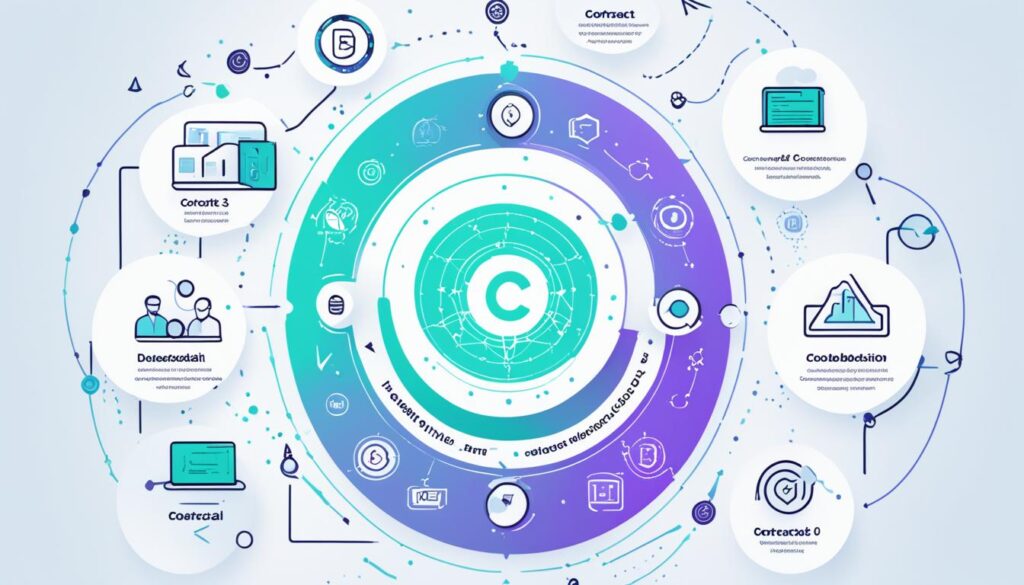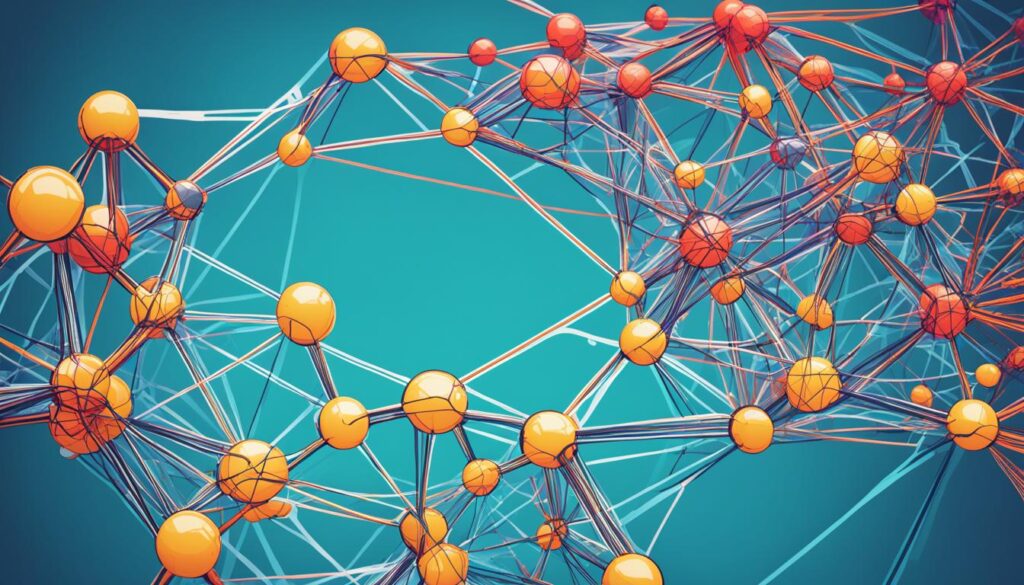Web 3.0 represents a revolutionary shift in the digital landscape, empowering individuals and communities with greater control over data, privacy, and decision-making processes. This paradigm embraces decentralization as a fundamental concept, offering a transformative impact on collaboration and decision making.
As we enter the era of Web 3.0, the world is witnessing remarkable growth in the global Web 3.0 blockchain market. Experts project a compound annual growth rate (CAGR) of 47.1% from 2023 to 2030, according to Grand View Research.
Key Takeaways:
- Web 3.0 represents a paradigm shift towards decentralization.
- It empowers individuals and communities with greater control over data, privacy, and decision making.
- The global Web 3.0 blockchain market is experiencing remarkable growth.
- Decentralized collaboration and decision making offer transformative benefits in Web 3.0.
- Trust, transparency, security, and user empowerment are key drivers of this shift towards decentralization.
The Building Blocks of Decentralization: Understanding the Key Features and Principles
Decentralization lies at the core of Web 3.0 innovation, offering a multitude of benefits for collaborative decision making. By understanding the key features and principles of decentralized systems, individuals and communities can fully leverage the advantages they bring.
Benefits of Decentralized Collaboration
Decentralized collaboration eliminates the need for intermediaries, allowing for direct peer-to-peer interactions. This promotes efficiency, privacy, and fosters a sense of trust among participants. With decentralized collaboration, individuals can collaborate freely, exchange ideas, and collectively work towards shared goals.
Web 3.0 Innovation
Web 3.0 introduces a paradigm shift by embracing decentralization as a fundamental principle. This innovation revolutionizes the way we interact with the internet, empowering users to have greater control over their data, privacy, and decision-making processes. By harnessing the potential of Web 3.0, individuals and organizations can create new digital experiences and drive transformative change.
Collaborative Decision Making in Web 3.0
In Web 3.0, collaborative decision making takes center stage. Distributed consensus ensures the integrity and immutability of data in decentralized systems, enabling collective decision making through network-wide agreement. This democratized approach allows for more inclusive and transparent decision-making processes, where the collective wisdom of the community is valued and utilized.
Advantages of Decentralized Decision Making
Decentralized decision making empowers individuals and fosters autonomy. Data sovereignty, a key principle of decentralization, puts the control and ownership of data in the hands of the individuals, allowing them to determine how their data is accessed and utilized. This ensures privacy, security, and gives power back to the users.
Understanding Decentralized Systems
Decentralized systems are built upon key features and principles that underpin their effectiveness:
- Peer-to-Peer Architecture: In decentralized systems, direct peer-to-peer connections eliminate the reliance on intermediaries. This promotes efficiency and privacy by allowing individuals to interact and collaborate freely.
- Distributed Consensus: Distributed consensus ensures the integrity and immutability of data across the decentralized network. This collaborative agreement mechanism enables collective decision making and enhances transparency.
- Data Sovereignty: Data sovereignty prioritizes the ownership and control of data by individuals. With data sovereignty, users have the power to determine how their data is accessed and utilized, increasing privacy and security.
These building blocks of decentralization form the foundation for the advantages of decentralized collaboration and decision making in Web 3.0. By embracing these principles, individuals and communities can harness the full potential of decentralized systems and shape the future of the internet.

Blockchain Revolution: Unveiling the Role of Blockchain Technology in Web 3.0
Blockchain technology is at the forefront of the Web 3.0 revolution, driving transformative advancements in the digital landscape. By leveraging distributed consensus and creating immutable ledgers, blockchain introduces a new era of trust, transparency, and security.
Consensus algorithms, such as proof-of-work and proof-of-stake, play a crucial role in ensuring the integrity and security of Web 3.0 networks. Through these algorithms, participants reach an agreement on the validity of transactions, eliminating the need for a centralized authority.

Tokenization and interoperability, two key features of blockchain, enable the representation and exchange of physical and digital assets on the blockchain. This facilitates frictionless transactions and increases liquidity, unlocking new possibilities in the digital economy.
“Blockchain technology is poised to revolutionize various industries, from finance and supply chain management to healthcare and entertainment,” says Susan Johnson, a leading blockchain expert. “Its impact on Web 3.0 extends far beyond cryptocurrencies, ushering in a new era of decentralized innovation and collaboration.”
Enhanced security and privacy are intrinsic to blockchain technology. The cryptographic techniques employed in blockchain networks protect against unauthorized access and data manipulation, ensuring the integrity and confidentiality of digital interactions.
As Web 3.0 continues to evolve, blockchain technology will remain a fundamental pillar, empowering individuals and organizations to participate in decentralized networks, transact securely, and reimagine traditional business models.
Automating Trust: Understanding the Role of Smart Contracts in Web 3.0
Smart contracts play a vital role in Web 3.0 by automating trust and revolutionizing the way agreements are enforced. Deployed on the blockchain, these self-executing contracts eliminate the need for intermediaries, providing a decentralized and efficient solution for collaboration and decision making in the digital era.
One of the key features of smart contracts is transparency. By being stored on the blockchain, all contract terms and conditions are visible to all participants, leaving no room for ambiguity or manipulation. This fosters trust among parties and ensures that agreements are executed as intended.
Another important aspect of smart contracts is their trustlessness. As they are self-executing and deployed on a decentralized network, smart contracts eliminate the need to rely on a single trusted authority. Instead, the code itself dictates the execution of the contract, guaranteeing fairness and impartiality.
Immutability is another noteworthy feature of smart contracts. Once a contract is deployed on the blockchain, it becomes an unalterable record of all interactions, creating a reliable and transparent audit trail. This eliminates the possibility of tampering or fraud and provides a verifiable history of all contractual obligations and transactions.
In Web 3.0, smart contracts empower individuals and communities by enabling decentralized decision making. By automating trust and eliminating intermediaries, smart contracts create a more inclusive and efficient environment for innovation and collaboration. They provide a secure and transparent foundation for various applications, including supply chain management, decentralized finance, and decentralized autonomous organizations (DAOs).
These innovations in Web 3.0 allow for greater autonomy, efficiency, and security in decision making, revolutionizing industries and reshaping traditional business models. With the ability to automate trust, smart contracts pave the way for a decentralized future where individuals have more control over their digital transactions and interactions.
Advantages of Smart Contracts in Web 3.0
| Advantage | Description |
|---|---|
| Transparency | Smart contracts stored on the blockchain provide visibility into all contract terms and conditions, ensuring clarity and trust among participants. |
| Trustlessness | Smart contracts are self-executing and operate on a decentralized network, eliminating the need for trust in a central authority and ensuring fairness. |
| Immutability | Once deployed on the blockchain, smart contracts become tamper-proof records of interactions, creating an auditable and verifiable history of contractual obligations. |
| Efficiency | Automating the execution of contractual obligations reduces the need for manual intervention, streamlining processes and reducing costs. |
| Security | Smart contracts leverage blockchain’s security features, such as cryptographic encryption and consensus mechanisms, to protect against unauthorized access and data manipulation. |
The impact of smart contracts in Web 3.0 extends beyond automation and trust. It democratizes decision making, promotes innovation, and enables new economic models built on decentralization. As more industries and organizations embrace the potential of smart contracts, the transformative power of Web 3.0 continues to unfold.

Conclusion
Web 3.0 represents a transformative shift in the way we interact with the internet. The advancements in Web 3.0 technology have paved the way for decentralized collaboration and decision making, offering numerous benefits and advantages.
By embracing decentralization, Web 3.0 provides enhanced security and privacy, ensuring that users have greater control over their digital identity and data. It reduces dependency on intermediaries, allowing for direct peer-to-peer interactions and promoting efficiency in the sharing of information and resources.
The advantages of decentralized decision making are also significant. Web 3.0 empowers individuals and communities by giving them a voice in the decision-making processes. This fosters inclusivity, encourages innovation, and enables more flexible and agile responses to emerging challenges and opportunities.
As we move towards a Web 3.0 future, it is essential for entrepreneurs and businesses to stay informed about the latest advancements, embrace experimentation, and leverage existing resources. By fostering collaborative ecosystems and addressing challenges such as scalability, interoperability, and governance frameworks, we can shape a future that reflects the values of openness, inclusivity, and empowerment.
FAQ
What is Web 3.0?
Web 3.0 represents a paradigm shift from the centralized architecture of Web 2.0, emphasizing decentralization in data, privacy, and decision-making processes.
What are the key features of decentralized collaboration in Web 3.0?
Decentralized collaboration in Web 3.0 offers benefits such as enhanced security and privacy, reduced reliance on intermediaries, and increased control over digital identity and data.
How does blockchain technology contribute to Web 3.0?
Blockchain technology plays a transformative role in Web 3.0 by leveraging distributed consensus, creating immutable ledgers, and enabling secure and transparent transactions.
What are smart contracts and their role in Web 3.0?
Smart contracts are self-executing agreements deployed on the blockchain, eliminating intermediaries and automating the enforcement of deal terms and conditions in Web 3.0.
What challenges does the adoption of Web 3.0 present?
The adoption of Web 3.0 poses challenges such as scalability, interoperability, and governance frameworks that need to be addressed to fully leverage its benefits.








